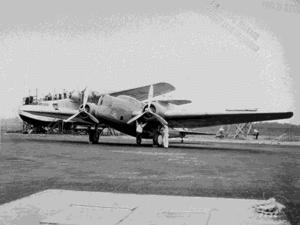Martin 146
The Martin Model 146 was an unsuccessful American bomber design that lost a 1934–1935 bomber design competition to the prototype for the Douglas B-18 Bolo (itself soon supplanted by the B-17 Flying Fortress).
| Model 146 | |
|---|---|
 | |
| Martin Model 146 during competition c. 1935, USAF photo | |
| Role | Heavy bomber |
| Manufacturer | Glenn L. Martin Company |
| First flight | 1935 |
| Status | Experimental prototype |
| Primary user | United States Army Air Corps (intended) |
| Produced | 1935 |
| Number built | 1 |
| Developed from | Martin B-10 |
Design and development
Although generally satisfied with the speed and bombload of the Martin B-10, the United States Army Air Corps expressed a requirement for a bomber with long range. Two competitions were held in 1934-35: one for fast bombers capable of flying 2,200 miles (3,500 km), and a second for the experimental prototype of a 5,000-mile (8,000 km) bomber.
The Martin 146 was built for the first competition, competing with the Boeing Model 299 (later the B-17) and Douglas DB-1 (later the B-18). Two versions were submitted for the competition, the Model 146 (actual aircraft) and the Model 146A (design only). The only significance between the two was the planform, the 146 center section was rectangular with the outer wing being tapered while the 146A had a constant taper.
The Model 146 bore a striking resemblance to the earlier Martin B-10, with the same configurations of turret and cockpits and even the same two Wright R-1820 Cyclone engines – albeit with 50% more power than the 600 hp Cyclones of the original B-10. The biggest differences between this aircraft and the Martin 139 (B-10) was that it was wider, allowing the pilot and co-pilot to sit side by side [1] and was equipped with Fowler flaps, the first large aircraft equipped with them.
The Model 146 was not successful but it led the Martin company to begin research into contemporary aviation technology. Some offshoots included the innovative Martin 145 proposed for the long-range bomber competition as well as the early studies that would lead to the Model 179 (later to emerge as the wartime Martin B-26). The aircraft was eventually returned to the factory and scrapped.
Specifications (Model 146)
Data from Martin 146 Specifications[2]
General characteristics
- Crew: 4
- Length: 52 ft 0 in (15.85 m)
- Wingspan: 75 ft 1 in (22.89 m)
- Height: 15 ft 5 in (4.70 m)
- Wing area: 729 sq ft (67.7 m2)
- Gross weight: 16,000 lb (7,257 kg)
- Max takeoff weight: 17,100 lb (7,756 kg)
- Powerplant: 2 × Wright R-1820-G5 Cyclone 9-cylinder air-cooled radial piston engines, 800 hp (600 kW) each
- Propellers: 3-bladed constant-speed propellers
Performance
- Maximum speed: 234 mph (377 km/h, 203 kn)
- Cruise speed: 204 mph (328 km/h, 177 kn)
- Range: 1,237 mi (1,991 km, 1,075 nmi)
- Service ceiling: 28,500 ft (8,700 m)
- Wing loading: 21.95 lb/sq ft (107.2 kg/m2)
- Power/mass: 0.100 hp/lb (0.164 kW/kg)
Armament
- Guns: 3 × .30 in (7.62 mm) Browning machine guns
- Bombs: 2,260 lb (1,030 kg)
See also
Related development
Aircraft of comparable role, configuration and era
Related lists
References
- Notes
- "Model 146." Archived 2007-08-26 at the Wayback Machine marylandaviationmuseum.org. Retrieved: 5 December 2o12.
- Martin 146 Specifications.' Archived 2012-02-25 at the Wayback Machine marylandaviationmuseum.org. Retrieved: 5 December 2012.
- Bibliography
- Baugher, Joe. "Martin B-10". Encyclopedia of American Aircraft. Retrieved: 4 July 2007.
- Taylor, John W. R. "Martin B-10". Combat Aircraft of the World from 1909 to the Present. New York: G.P. Putnam's Sons, 1969. ISBN 0-425-03633-2.
External links
| Wikimedia Commons has media related to Martin 146. |